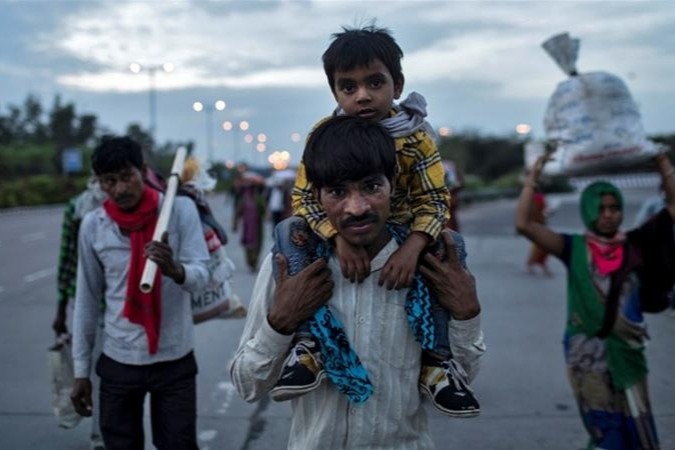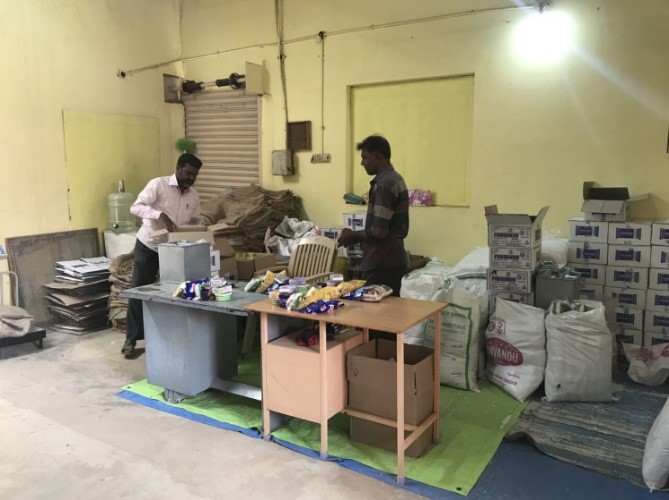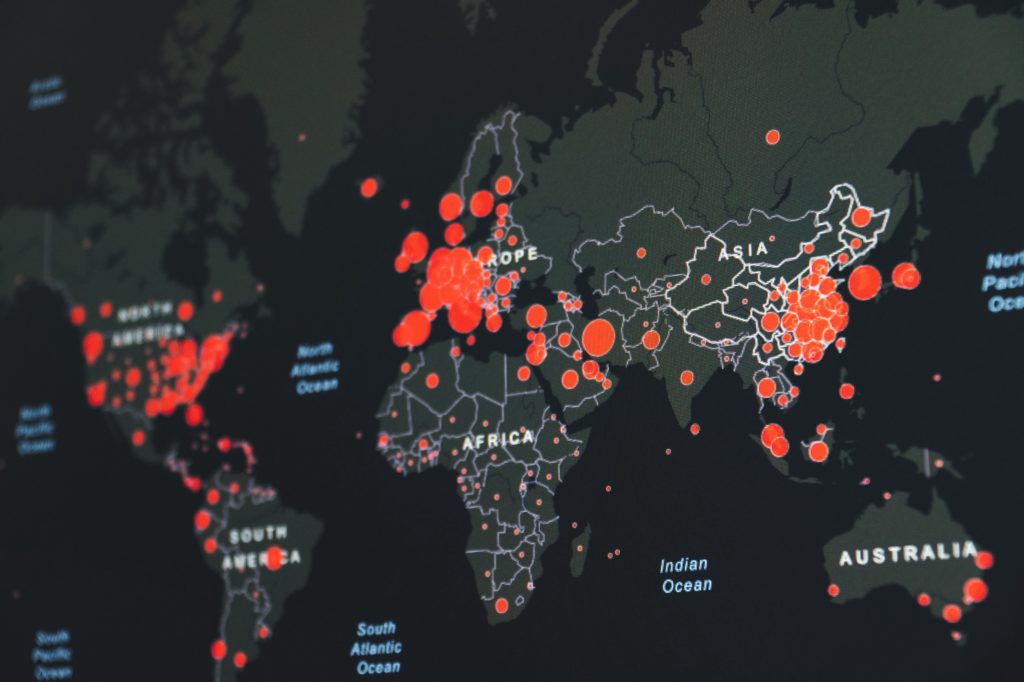The COVID-19 pandemic requires reconsidering the relationship between data and invisible populations as a form of de facto civil inclusion. While most forms of data management of populations are problematic, under which conditions would counting be just?
Annalisa Pelizza and Yoren Lausberg, Processing Citizenship research program, University of Bologna
Stefania Milan, DATACTIVE research program, University of Amsterdam
This post was originally published on Open Democracy on April 28, 2020
On March 13th, in announcing that Europe had become the epicenter of the COVID-19 pandemic, World Health Organization’s Executive Director Dr Michael Ryan made a plea in favor of invisible populations. “We cannot forget migrants, we cannot forget undocumented workers, we cannot forget prisoners,” he argued. In just a few days, civil societies around the world would have discovered that invisibility is indeed a recurrent companion to the virus. Exceptionally hard to contain due to its asymptomatic contagion and long incubation period, COVID-19 has also been hard to classify as a cause of death, complicating the efforts to trace it and count its victims. Despite narratives about its alleged democratic character, the virus seems to hit the weak, invisible populations the hardest. The elderly confined in care homes are decimated across Europe, largely uncounted. From China to Pennsylvania the toll of people passed away in the solitude of their homes—or of their shelters—does not appear in official statistics. Undocumented migrants are dying from the virus because they are too afraid to seek help, and their numbers typically do not reach official statistics. If today “being counted” is even more so a condition of existence and care, Western countries are failing to account for the health conditions of invisible populations like people on the move. In the days of COVID-19 as never before, what these dramatic (missing) numbers make apparent is that invisibility may mean death.
The COVID-19 pandemic puts us in front of a dilemma with regards to invisibilized populations, and migrants in particular—one which has to do simultaneously with societal and technological concerns. On one hand, visibility gaps are a systemic aspect of population management that might be welcomed by policy makers and populations alike. Indeed, the illusion of a “data panopticon” does not take into account the conditions of data collection, data gaps and the limits of system interoperability: not everyone is counted in all systems, and not in the same way. Such invisibility might serve the needs of informal economies and unscrupulous politicians ready to mobilize security concerns. From a different perspective, from homeless to prisoners, from migrants to sex workers, invisibility can be deemed a protection from care that too often resembles control and surveillance.
On the other hand, a surge in the visibility of migrant populations might help curbing the contagion and avoiding massive spreads within vulnerable populations. Indeed, being invisible translates into the inability to access crucial services in the time of the pandemic, and health care above all. Access to testing and cure requires insurance, and insurance requires being countable. Even when the costs of insurance can be offset by the collectivity, being countable remains a key condition of access. In the U.S., for example, the second coronavirus relief package known as the Families First Coronavirus Response Act has extended testing to the Medicaid-eligible population, even when uninsured, but not to undocumented migrants, nor to other temporary residents.
We suggest that, while in normal conditions populations on the move may prefer to remain invisible rather than face repression, stigma or deportation, the current situation requires to reconsider the relationship between data, populations and (in)visibility. We thus wonder under which conditions including invisibilized populations in the general COVID-19 count could turn out a just solution. For sure, some cautions should be used. In the best case scenario, instead of exposing vulnerable populations, such reconsideration might even entail a de facto form of civil inclusion. What follows makes the point by considering migrants and undocumented populations as especially vulnerable to COVID-19 due to their invisibilized status in official registries and administration, and the barriers to formal and professional care that this invisibility entails. While most of our examples originate in the European continent, our main terrain of study, we believe that there is something universal in this exercise that can also inform the way other countries and communities relate to people in the move in the time of the pandemic.
People on the move do not show in COVID-19 counts
António Vitorino, Director General of the International Organization for Migration has recently called for a universal response to COVID-19, regardless of migratory status. Portugal has specifically addressed the migrant condition in its response to the pandemic. It has extended to third country nationals with pending applications access to the same services of the resident population: from national health care to welfare benefits, from bank accounts to work and rental contracts. The Portuguese response constitutes a temporary de facto inclusion of foreign citizens, in the name of pragmatism as well as of human rights. It is however unique in a continent that has rather halted most bureaucratic procedures and data processing involving people on the move. Sweden, The Netherlands and Belgium have suspended administrative services for migrants, refugees and asylum-seekers. After having halted asylum procedures, Greece has put migrants living in overcrowded camps under quarantine. In Serbia, along the so-called Balkan Route, armed forces have taken over the security of about 150 social welfare institutions, 120 medical facilities and 20 migrant camps, de facto locking migrants in. Similarly, Bosnia Herzegovina has introduced tighter controls in the reception centres, which migrants and refugees can no longer leave or enter. Italy has declared its ports “unsecure”, asylum and police offices are closed and data processing suspended. Meanwhile, an estimated 200,000 undocumented farmworkers in Italy live in cramped informal settlements in precarious hygienic conditions and without running water, which makes it impossible to implement the social distancing and hygienic measures imposed to slow down the contagion. In France many sleep in makeshift camps or on the streets, with local nongovernmental organizations (NGOs) sounding alarm bells about an upcoming “health scandal”, and questioning the government’s lack of adequate response. In the UK, NGOs point out that the suspension of various support networks increasingly puts already precarious people at risk, noting how the hostile environment deters undocumented people from seeking help. All in all, in many European countries migrants are not included in COVID-19 counts, equally hindering access to care and relief systems. What are the consequences of this situation, and how can it be overturned?
The consequences of invisibility
Invisibility of moving populations in time of pandemic can have health, economic, and social consequences. First, we do see that its effects stack on existing social and institutional inequalities. Vulnerable populations are left behind in addressing the public health threats of the coronavirus outbreak. As already hostile environments bar mobile populations from seeking professional and official health care, the spread and effects of the coronavirus will be exacerbated among these populations. They are already vulnerable due to a lack of accessible information and access to hygiene facilities, but also because their economic vulnerability may force them to seek employment when others can choose to stay at home. The exclusion of some people from comprehensive efforts to counter the spread of COVID-19 will cause harsher and prolonged sanitary effects among these groups. With effects not only on their wellbeing, but also on the general wellbeing of society at large, as failure to contain the virus will exacerbate its spread.
Second, invisibility may entail dramatic asymmetries in economy and labor relations. Not only invisibility allows exploitation in agricultural economies, construction work and temporary job markets, among others. It also marks a harsh asymmetry between migrant workers’ contribution to the COVID-19 response and their under-representation in statistics. For instance, European countries like Austria and Germany are importing farmhands from Eastern Europe to harvest seasonal vegetables like asparagus. The Italian Minister of Agriculture Teresa Bellanova has recently proposed to give some of the estimated 600,000 undocumented immigrants in the country temporary work permits to plug the labor gap which is particularly large and urgent in the agri-food sector. Yet counting as well as rights asymmetries continue to permeate job sectors that are key in the corona response. Food delivery workers in European cities are largely migrants who cannot afford to “stay home” and lose income. According to the Migration Policy Institute, in the U.S. foreign born represent 38 percent of home care and significant shares of workers in food production and distribution, all sectors at the coronavirus response frontline.
Third, invisibility has societal consequences too, as it helps fueling racism and xenophobic reactions. In Italy, for example, pseudoscientific myths are spreading on social media, in a country where often migration is associated with heterogeneous skin traits and hospitalized patients are largely white. Not only do these resurgent racialized explanations of alleged immunity to the virus fuel racist narratives, lack any scientific base and disregard empirical evidence of Afro-American communities tragically and disproportionally hit by the virus on the other side of the Atlantic. They also reignite racial classifications and genetic pseudoscientific thinking that we hoped were buried with XIX century colonial anthropology. Furthermore, they counteract socio-scientific explanations and consequent policy action. If temporary residents are less prone to ask for support in case of COVID-19 symptoms, this might be due to their tendency to associate the health care system with repressive authorities, scarce linguistic skills or fragmented social networks: all explanations that should be investigated in order to curb the contagion.
Our proposals for just visibility
All things considered, one might wonder whether the current emergency requires reconsidering the relationship between data, visibility and populations. Institutional solutions appear to timidly move in the direction of making migrant populations more visible. In Italy, the introduction of mandatory self-certification to exit home was sufficient to halt the agricultural production chain, as work force is mainly constituted by irregular migrants. As a result, the Italian Agriculture Ministry is attempting to overcome the impasse by creating a new registry of agricultural labor. Even U.S. scholar and author Shoshana Zuboff, a well-known fierce critic of what she herself terms “surveillance capitalism”, in an interview with the Italian daily “La Repubblica” has surprisingly argued that contact tracing apps should be mandatory and data should be managed by public bodies. But Zuboff’s argument falls short when it meets vulnerable populations who are not longing to be traced and are inherently suspicious of authorities. Becoming visible through an app of this kind does not fit well with the fears of repression and deportation these vulnerable population live with.
The question is therefore how can visibility be just? The various consequences of invisibility we have identified do not exist in isolation. Forms of invisibilization stack upon each other. As mentioned above, mobile populations often work in already precarious or exploitative sectors, which have suddenly become foregrounded as “essential” during the pandemic. This creates the paradox that while the work is visibilized as vital, the workers are barred from accessing civil rights, are still kept out of the count and thus excluded from aid and relief. It is then crucial to consider what inclusion in the COVID-19 response is for: is it a temporal visibilization in disease tracing and tracking, so that those who have been immunized can return to orchards and elderly houses to become invisibilized workers again? Or will access to civil rights be granted on a permanent basis to all who are still excluded from it?
In facing the visibility/invisibility dilemma for populations on the move, diverse scenarios open up—from repressive authorities taking advantage of the temporal disclosure to identify and track undocumented migrants, to a de facto form of civil inclusion. De facto inclusion would entail universal access to civil institutions such as health care, welfare and civil rights. It would be an infrastructural (but nevertheless political) way to perform people on the move as members of civil communities, while at the same time protecting them through civil rights. De facto inclusion would entail protected visibility. In what follows we reflect on the conditions under which the counting of invisibilized populations can lean towards this second scenario.
We argue that a multipronged approach is needed to address the problem of making the invisible population of migrants countable under fair conditions. Firstly, we need to give careful consideration to how we count and what digital infrastructure we use toward this end. For starters, counting should respect the principles enshrined in the EU General Data Protection Regulation, most notably data minimization (i.e., data collection should be limited to what is necessary) and purpose limitation (i.e., data should be collected for specific, explicit and legitimate purposes). But it should also commit to fairness and transparency, whereby personal data should be processed in a way which is transparent to data subjects, and, we would add, abide to democratic oversight and accountability. In other words, the counting we propose should be finalized to protection of vulnerable populations and the societies surrounding them, rather than exclusion, discrimination or repression. To this end, we need to ensure that data collection and use are discrimination- and future-proof, and that data about, for instance, health conditions collected during the pandemic emergency are not used against these vulnerable populations at a later stage. In this process of envisioning fair rules for counting vulnerable populations, the infrastructure dimension is to be given adequate consideration. Although “invisible” in themselves, digital infrastructures–including how they are designed, integrated and who owns them–are an integral part of any decision-making with regards to counting, especially for what concerns the public versus private ownership and oversight.
Secondly and strictly related, access to civil rights for people on the move must also include the right to be deleted from any database, and to not be traced beyond the original goals (i.e., the purpose limitation mentioned in GDPR). Data about people who have been on the move are already stored in systems of identification and registration used at the border, with the risk of carrying stigmas far and wide. On top of that, entering a health care or welfare database often means enlisting a system of cross checks that can be invasive of personal life and heavily influence intimate choices. As many counts and registries are also modes of control and surveillance, inclusion should also mean inclusion in the right to be forgotten. Furthermore, any restrictive or invasive measure should come with adequate sunset provisions, whereby any data collection that is in some way invasive of people’s privacy can cease to have effect when, e.g., a vaccine becomes available and widely administered.
Thirdly, as we know that the practice of counting speaks for the counter more than for the counted, we propose an alliance between different counting entities rallying around the need for public critical care. These entities include, at the bare minimum, migrant-led organizations, shelters, health care institutions, unions, and organizations close to the ground. This comes with its own set of challenges, including database interoperability issues and principles, as various organizations will have to gather around a concern for care and public health coming with their own experiences and values. The alternative would however leave us with a prolonged public health crisis or centralizes state authorities or private corporations in the collection of population data.
Finally, and most importantly, the counting we propose should take stock of the European migration regime, and invert the priority given since 2015 to securitization at the expenses of health data. Our research at Processing Citizenshiphas indeed shown that in European frontline countries the assessment of health conditions was originally the primary concern upon disembarkation of people rescued at sea. However, with the so called “Hotspot approach” introduced in 2015 priority has been shifted to fill administrative databases for security concerns. If anything, COVID-19 is a powerful reminder of the need to restore the original priority given to health data in population management, rather than to administrative information. In sum, we argue that identification and tracking of migrants for purely security purposes should be replaced by health care assessment through specialized, non-interoperable information systems that count together resident populations and those on the move.
To conclude, we cannot but note that the bulk of our proposals—especially around data protection, data minimization, purpose limitation, sunset clauses—are valid also in the deployment of contact tracing apps for the general population. Which leads us to wonder to what extent any counting measure to contain the virus can be effective while distinguishing among populations. By considering how to fairly include invisibilized populations in what is today’s most pressing count, we might end up realizing that even most classifications for visible populations are being redefined. A more comprehensive solution to this conundrum would be rethinking critical services to include all residents of a given polity, regardless of their status. If so, the challenge is making sure that this redefinition is as inclusive as possible. This might mean changing the ways Europe sees its people and who these people are, and ultimately the role of data infrastructures in this inclusive recounting.
Acknowledgements
The authors wish to thank Chiara Milan (University of Graz) for sharing her knowledge about the current situation in the Balkans concerning populations on the move and the pandemic.
The authors disclose receipt of the following financial supports for the research, authorship, and publication of this article: Processing Citizenship (2017–2022, Grant Agreement No. 714463) and DATACTIVE (2015–2020, Grant Agreement No. 639379), both of which have received funding from the European Research Council (ERC) under the European Union’s Horizon 2020 research and innovation program.










